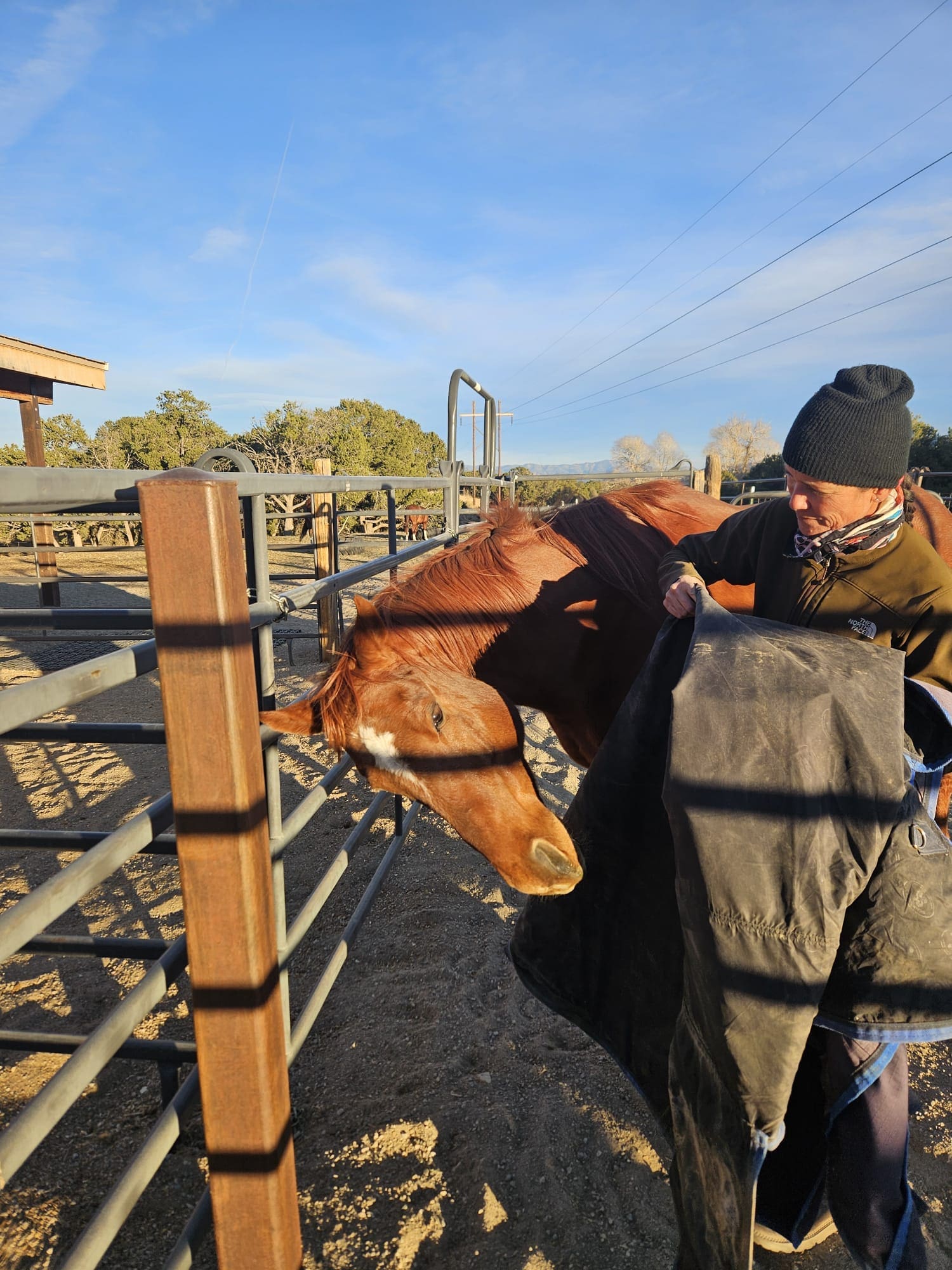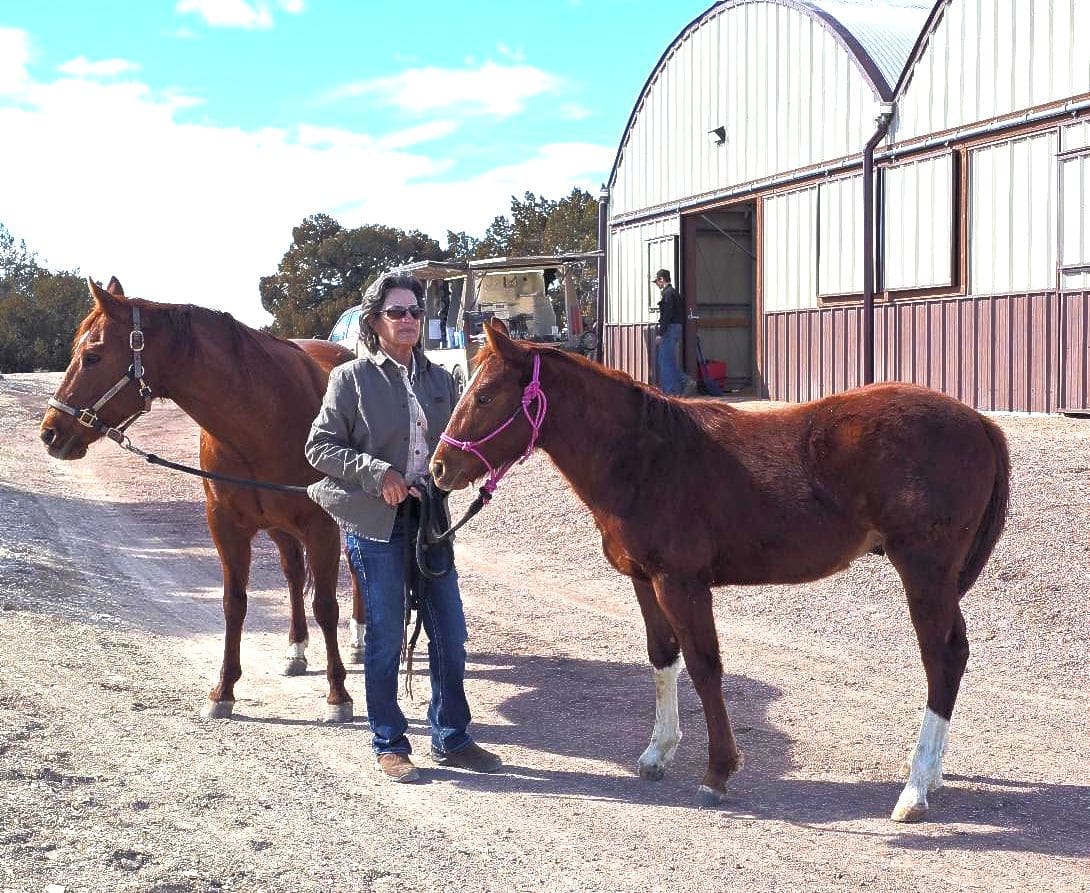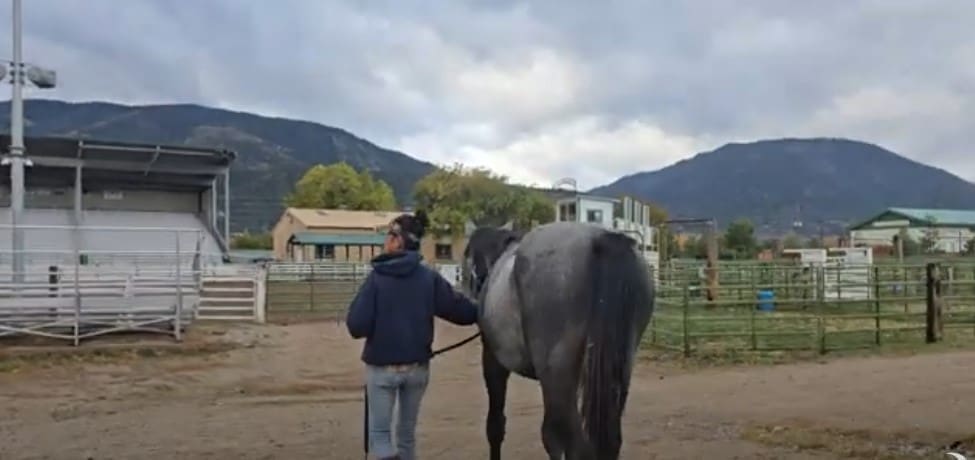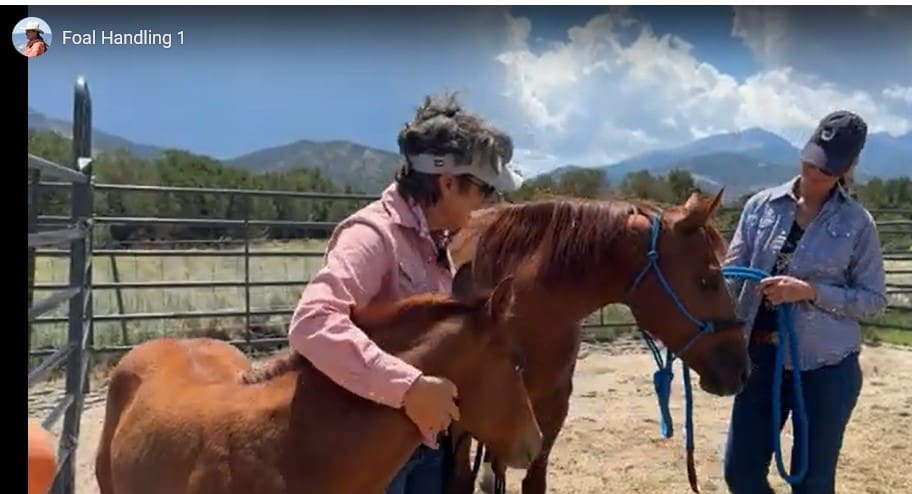By: Heidi Melocco with Julie Goodnight
Top trainer/clinician Julie Goodnight gives you three fun activities designed to enhance the bond you have with your horse and solidify your role as herd leader.
During cold winter months, you likely trail ride less frequently than you do in warmer months. You might even turn your horse out on winter pasture. And all year long, there are times when you just can’t get out to ride as often as you’d like.
You can take a break from riding, but you still need to keep your horse tuned up so he maintains his respect for you as his herd leader, especially if he’s pastured with other horses.
As a prey animal, your horse instinctively looks for safety and comfort in a horse herd. If he doesn’t also feel safe and at home with you, he’ll feel unsafe, insecure, and alone when you pull him out of his herd.
“Unless and until you can replace those feelings of safety and comfort that your horse gets with his horse herd, he’d rather stay with his buddies,” notes top trainer/clinician Julie Goodnight.
“Your horse will leave with you only if he thinks you can give him safety, security, and comfort. You have to be a herd of two.”
If your horse doesn’t feel safe with you, he might become herd-bound, barn sour, buddy sour, and even appear to forget his training.
It may be tough to ride your horse every day, especially in the winter. But you can make sure that each interaction you have with him is meaningful and shows him you’re his herd leader.
“It’s all about relationships,” says Goodnight. “You have to consistently work with your horse to maintain a good relationship. Some horses need to be handled every day. The good news is that helping your horse feel safe with you can be fun.”
Here, Goodnight will explain the importance of tuning up your horse’s training all year long. Then she’ll give you three fun activities designed to foster your relationship and bond with your horse so he’ll look to you as his trusted leader.
Tune Up His Training
First, understand how your horse thinks. He understands authority and leadership. He’s always testing you. If he finds he doesn’t have to follow the rules with you, he won’t.
Every time you handle your horse, you’re training him to do something, either acceptable or unacceptable. Over time, tiny inconsistencies can erode your authority with him, but you might not notice that you’re no longer the leader until something big happens.
Consistently keep up your horse’s training, whether you bought him trained or trained him yourself. If you allow him to break the rules, and abandon the structure and routine he’s learned, his training is likely to unravel. He’ll lose his respect for you as the herd leader, and may even resist leaving the pasture.
For instance, let’s say you’ve trained your horse to stand still during grooming. Over time, he starts taking a step or two toward you as you brush him. You don’t bother to correct him. Then one day, he takes three steps and actually bumps into you.
You thought those small steps were little infractions not worth correcting. But your horse took your inaction as a sign that you’re not in charge and not even worth noticing.
Teach your horse to respect your personal space. Every time you lead him, make frequent stops and starts, requesting obedience. Remind him where he should be. Don’t allow him to get ahead of you. Make sure he stands still when asked. Correct him if he bumps into you or takes a step away from you.
Another example: You’ve trained your horse to ride out alone. But then you start allowing him to turn his head to look back toward the barn. Left uncorrected, he soon attempts to turn back toward the barn, and balks when you turn him toward the trail.
To keep up your horse’s training, correct him with confidence every time he looks back toward the barn. He’ll remember that first-trained skill.
Goodnight says that in her experience, middle-aged horses, no matter how well-trained, are more likely to become herd-bound than other horses. There are variables in personalities, but that’s a time to make sure you interact with your horse and maintain your leadership.
Five minutes of training here and there can go far to help you maintain your relationship with your horse, especially if the relationship is firmly established.
And the more you spend time increasing your leadership and enhancing the bond with your horse, the more relaxing and enjoyable your trail rides will be. When your horse trusts you and sees you as his herd leader, he’ll more readily follow your cues, and you’ll have a more productive and relaxing time in the saddle.
Following are three short, fun activities you can do with your horse to help keep up his training and enhance the bond you enjoy with him.
Activity #1: Find His Sweet Spot
A fun activity to do with your horse as you groom him is to rub and scratch his “sweet spot.” When something feels good to a horse, he’ll pucker his lip and even raise or stretch out his neck to show you his appreciation. This reaction is related to allo-grooming(mutual grooming). When two horses stand facing one another and groom one another with their teeth, they’ll pucker when the other horse has found the “sweet spot.” Julie Goodnight’s Grooming Tools
Only horses that are bonded will participate in mutual grooming. In that pair, one is still more dominant; the dominant horse will start and stop the process.
To find your horse’s sweet spot, start at his withers, and rub in a circular motion up his neck with a deep massaging or scratching motion. When you find the sweet spot, he’ll move his lips or even stretch out.
Scratch your horse’s sweet spot after you’ve asked him to perform a maneuver, such as stopping, backing up, or taking a step to the side.
Be aware that you’re working to maintain your leadership within the herd. By initiating and stopping this routine, you’re showing him you’re the herd leader.
Sometimes horses that are allo-grooming will bite each other, so you’ll need to thwart any mouthy behavior. Your horse should never put his lips on you. If he does reach out to groom you in return, acknowledge the kind gesture, but gently push back his nose back to stop him.
And don’t allow your horse to become rude or demanding of the grooming or reward. If he becomes demanding, be demanding back, and tell him that it’s not the right time. Never reward this behavior.
Activity #2: Play the Bravery Game
Ground work builds your relationship with your horse. One fun groundwork activity is the “bravery game,” which teaches him to replace his flight response with a calm alternative.
This is a great skill to have when you’re on the trail. If your horse sees something that scares him, he’ll know that he’s brave enough to stop, turn, look, and draw closer to the scary object.
For this activity, you’ll work with your horse’s instinctive behavior. By nature, he’s investigative and curious. If he sees something new, and he’s unafraid, he may seek to touch the object with his muzzle and even lick it. Your horse is also instinctively a flight animal. However, he can’t act on both of these instincts at the same time.
Here’s how to replace your horse’s flight instinct with investigative behavior when confronted with a scary object.
Step 1. Find a novel item. Once a week or so, find a novel, noisy, visually stimulating item to present to your horse, such as a pinwheel, pom-pom, or plastic toy with moving parts. Place the item behind the barn or next to an out-of-the-way building, where it’ll surprise him.
Step 2. Lead your horse. Outfit your horse with a rope halter and training lead at least 12 feet long. Ask him to walk obediently beside you, stop, back up, etc. Then lead him past the item.
Step 3. Ask him to face the item. As soon as your horse sees the item, ask him to stop. If he moves, correct him with the lead rope. Then ask him to face the item.
Step 4. Praise him. As soon as your horse stops and faces the item, praise him with long strokes of your hand and with your voice. Such praise will calm him. Just relaxing near the novel stimulus will help eliminate his flight instinct.
Step 5. Ask for a step or two. If your horse stays calm, ask him to take a step or two toward the item, then ask him to stop again. If he stays put, praise him for his bravery. Continue to ask him to take one or two small steps forward, but don’t let him walk far. Stop him after he goes only a short way.
Step 6. Encourage investigative behavior. The moment your horse pricks his ears forward and shows forward interest, ask him to walk another step, then stop him again. Going slowly and stopping him piques his investigative instinct, and gives him a chance to take in the new stimulus. It also gives you a chance to praise him and help him to stay relaxed.
This activity is a game as well as a training session. It’s fun for your horse, because he wants to be told he’s good. He doesn’t like being afraid, so when you help him replace fear with bravery, he feels good.
The ultimate point in the game comes when your horse reaches out and touches the item with his muzzle. He wins! Praise him copiously with long strokes of your hand and your voice
If you only have five minutes, do a shorter version of this activity. Place a piece of noisy plastic in your pocket, then take it out, crinkle it, and show it to your horse. If he stays relaxed, praise him. If he becomes nervous, ask him to calm down and face the item.
You can also do the bravery game while you’re riding — even when your horse is accidentally startled. Simply follow the same steps you performed on the ground.
The more often you do this activity, the more often your horse will stop and look instead of thinking of bolting. He may still be startled, but he’ll learn to turn and look instead of taking off.
Activity #3: Ride With Friends
If you make small efforts to constantly improve your horsemanship, you’re horse will be happier, because you’ll learn how to better communicate with him. To keep on a regular schedule, set aside a dedicated time, and include your friends.
One way to do this is to start a once-per-month riding club. Rotate the leader who’ll prepare a lesson that’s fun and educational.
The leader needs to be aware of every member’s skill level so he or she can design exercises that are meaningful for all involved.
The leader will first show the rest of the group what to do. Then everyone else will follow. Afterward, you’ll all talk about what worked, what didn’t, and why.
If time is short, perform ground work, then hold a brief contest. For instance, see whose horse will ground-tie the longest. Give a fun prize to the winner. When you have time, serve after-lesson refreshments.
For more information on equine behavior and trail-riding tips, see Goodnight’s Guide to Great Trail Riding, with bonus DVD, available at Shop.JulieGoodnight.com



